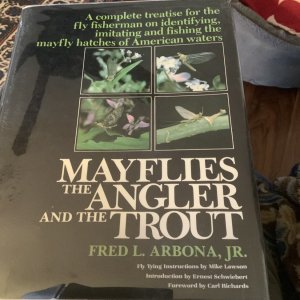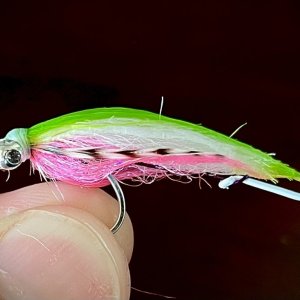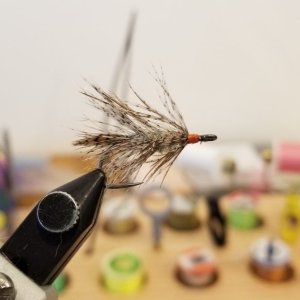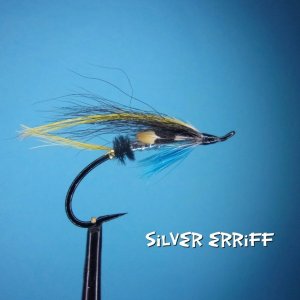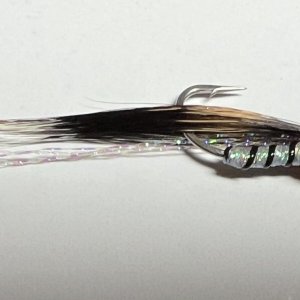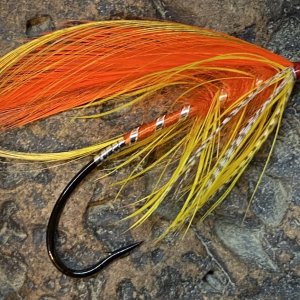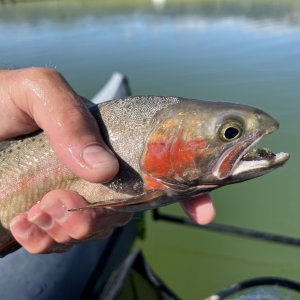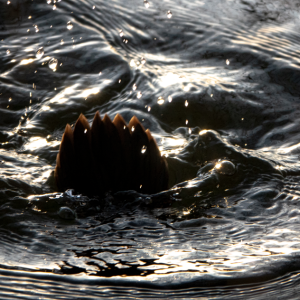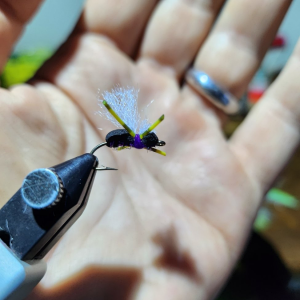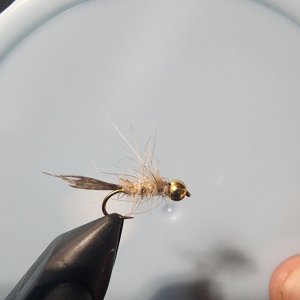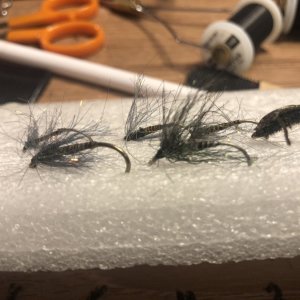You are using an out of date browser. It may not display this or other websites correctly.
You should upgrade or use an alternative browser.
You should upgrade or use an alternative browser.
Lenice/Nunnally size of fish?
- Thread starter Ronbow
- Start date
T
Tombraider
Guest
Will be East next week, think I may see what's in Lenice, only been there once for a skunk.
T
Tombraider
Guest
Plans crushed again. Rrr
IF WDFW had the intent and the knowledge to manage this lake correctly, it would probably still grow pigs. Some of my first float tube outings with my dad happened at Lenice. I would have been about 6 or 7.
WDFW seems to have a similar management plan for most lakes: dump a bunch of fish in so people can easily catch fish. However, it would be great if they managed a handful of lakes for "serious" anglers who wanted higher quality fish. But they don't care about us.
WDFW seems to have a similar management plan for most lakes: dump a bunch of fish in so people can easily catch fish. However, it would be great if they managed a handful of lakes for "serious" anglers who wanted higher quality fish. But they don't care about us.
Managed correctly for who? Lenice is a put and take lake.IF WDFW had the intent and the knowledge to manage this lake correctly, it would probably still grow pigs. Some of my first float tube outings with my dad happened at Lenice. I would have been about 6 or 7.
This is exactly what they do.However, it would be great if they managed a handful of lakes for "serious" anglers who wanted higher quality fish.
Managed correctly for who? Lenice is a put and take lake.
This is exactly what they do.
@_WW_ - Shhhhhh! ;-)
Although Rex might not believe it, sometimes I do listen to him and think about what he says: @Starman77 thinks many of our put and take (bait fishing allowed) lakes get fished hard the first few weeks of the opener and then are pretty much left alone. The take the trout home and freeze them crowd thin out the trout population leaving a much richer food source for the surviving fish. Those survivors often grow quickly and hold overs are something Rex actively pursues.
N. Metz - what would correct management of the Lenice look like. Planting densities (fish/acre), species and size at time of release, etc.
What does the "serious" angler consider to be higher quality fish? I always look forward to posts by anglers like Billy and Tripoidjunkie which annually seem to catch and number of what I would consider to be quality fish that I believe are coming from Washington lakes.
Curt
What does the "serious" angler consider to be higher quality fish? I always look forward to posts by anglers like Billy and Tripoidjunkie which annually seem to catch and number of what I would consider to be quality fish that I believe are coming from Washington lakes.
Curt
Here would be my plan for establishing a quality lake…..This won’t ever happen but you can always dream.
It would also likely be easier on lakes without inlet and outlet streams.
First, rehab the lake. Rehabbing doesn’t seem to happen as often as it did years ago. Once the lake has been rehabbed, plant it with fry. Keep the planting numbers on the low side in regards to fish per acre. Continue low number of fry plants in subsequent years. The regulations would be put & take.
By the third year after the rehab, what fish do survive would be what I’d consider quality fish based on my past experience.
When productivity and undesirable species populations reach a point where the fishing isn’t good any longer, rehab it again.
If rehabs were staggered over a number of lakes, you could theoretically have quality fishing opportunities annually at certain lakes depending on where they were in the post rehab process.
Another option would be to have a real triploid trout program, like BC has. Not the piece of crap triploids that WDFW currently plants.
SF
It would also likely be easier on lakes without inlet and outlet streams.
First, rehab the lake. Rehabbing doesn’t seem to happen as often as it did years ago. Once the lake has been rehabbed, plant it with fry. Keep the planting numbers on the low side in regards to fish per acre. Continue low number of fry plants in subsequent years. The regulations would be put & take.
By the third year after the rehab, what fish do survive would be what I’d consider quality fish based on my past experience.
When productivity and undesirable species populations reach a point where the fishing isn’t good any longer, rehab it again.
If rehabs were staggered over a number of lakes, you could theoretically have quality fishing opportunities annually at certain lakes depending on where they were in the post rehab process.
Another option would be to have a real triploid trout program, like BC has. Not the piece of crap triploids that WDFW currently plants.
SF
SF -
Your "plan" would work and in fact for decades it was the preferred option by the Department of Game (Wildlife, Fish and Wildlife). Unfortunately for most of the lowland lakes in Washington is not longer a valid option. This is due to a variety of reason. In most of western Washington that option essentially ended in the 1980s.
Perhaps the following example will illustrate why WDFW biologists stop using this option on the west side. In fall 80 Blackman's Lake located on outskirts of Snohomish was "rehabbed" to rid the lack of a mixed of warm water species. The treatment killed largemouth, yellow perch, black crappie, pumpkinseed sunfish and brown bullhead (catfish?). At the time those opposed to the rehab were concern that the State could not rid of the lake of the brown bullheads. Sure enough the survival of trout was not what was expected and by year 3 post rehab had fallen to very low levels. The decision was made to try again to rehab the lake again in the fall of 1984. The lake was treated again killing the expected species; largemouth bass, yellow perch, black crappie, and pumpkinseed sunfish. In addition, crap, fathead minnows and bluegill sunfish were killed; three new species on been introduced (illegally) post the 1980 rehab and the one species that thought to be the biggest problem to kill in the 1980 treatment was absent.
The problem of the continue illegal introduction of exotic species, I remember one case were about 3 weeks after a lake treatment a dozen or so freshly dead largemouth were found at the boat launch. The bucket biologists were helping the state with the lake management even before any trout were planted. The final nail in coffin for that approach on double crested cormorants turning to the foraging on the lakes in the winter after the collapse of PS hake (whiting).
I don't know the details of the management problems on the east side as well though am told that difficulties include wide spread warm water species in lake watersheds and the illegal introduction of those species.
I'm sure the today's WDFW biologists wish that lake treatment was still a more viable option. Prior to about 1980 it was not uncommon to have 6 to 20 years of productive trout fry survival following a lake treatment.
Curt
Your "plan" would work and in fact for decades it was the preferred option by the Department of Game (Wildlife, Fish and Wildlife). Unfortunately for most of the lowland lakes in Washington is not longer a valid option. This is due to a variety of reason. In most of western Washington that option essentially ended in the 1980s.
Perhaps the following example will illustrate why WDFW biologists stop using this option on the west side. In fall 80 Blackman's Lake located on outskirts of Snohomish was "rehabbed" to rid the lack of a mixed of warm water species. The treatment killed largemouth, yellow perch, black crappie, pumpkinseed sunfish and brown bullhead (catfish?). At the time those opposed to the rehab were concern that the State could not rid of the lake of the brown bullheads. Sure enough the survival of trout was not what was expected and by year 3 post rehab had fallen to very low levels. The decision was made to try again to rehab the lake again in the fall of 1984. The lake was treated again killing the expected species; largemouth bass, yellow perch, black crappie, and pumpkinseed sunfish. In addition, crap, fathead minnows and bluegill sunfish were killed; three new species on been introduced (illegally) post the 1980 rehab and the one species that thought to be the biggest problem to kill in the 1980 treatment was absent.
The problem of the continue illegal introduction of exotic species, I remember one case were about 3 weeks after a lake treatment a dozen or so freshly dead largemouth were found at the boat launch. The bucket biologists were helping the state with the lake management even before any trout were planted. The final nail in coffin for that approach on double crested cormorants turning to the foraging on the lakes in the winter after the collapse of PS hake (whiting).
I don't know the details of the management problems on the east side as well though am told that difficulties include wide spread warm water species in lake watersheds and the illegal introduction of those species.
I'm sure the today's WDFW biologists wish that lake treatment was still a more viable option. Prior to about 1980 it was not uncommon to have 6 to 20 years of productive trout fry survival following a lake treatment.
Curt
SF -
Your "plan" would work and in fact for decades it was the preferred option by the Department of Game (Wildlife, Fish and Wildlife). Unfortunately for most of the lowland lakes in Washington is not longer a valid option. This is due to a variety of reason. In most of western Washington that option essentially ended in the 1980s.
Perhaps the following example will illustrate why WDFW biologists stop using this option on the west side. In fall 80 Blackman's Lake located on outskirts of Snohomish was "rehabbed" to rid the lack of a mixed of warm water species. The treatment killed largemouth, yellow perch, black crappie, pumpkinseed sunfish and brown bullhead (catfish?). At the time those opposed to the rehab were concern that the State could not rid of the lake of the brown bullheads. Sure enough the survival of trout was not what was expected and by year 3 post rehab had fallen to very low levels. The decision was made to try again to rehab the lake again in the fall of 1984. The lake was treated again killing the expected species; largemouth bass, yellow perch, black crappie, and pumpkinseed sunfish. In addition, crap, fathead minnows and bluegill sunfish were killed; three new species on been introduced (illegally) post the 1980 rehab and the one species that thought to be the biggest problem to kill in the 1980 treatment was absent.
The problem of the continue illegal introduction of exotic species, I remember one case were about 3 weeks after a lake treatment a dozen or so freshly dead largemouth were found at the boat launch. The bucket biologists were helping the state with the lake management even before any trout were planted. The final nail in coffin for that approach on double crested cormorants turning to the foraging on the lakes in the winter after the collapse of PS hake (whiting).
I don't know the details of the management problems on the east side as well though am told that difficulties include wide spread warm water species in lake watersheds and the illegal introduction of those species.
I'm sure the today's WDFW biologists wish that lake treatment was still a more viable option. Prior to about 1980 it was not uncommon to have 6 to 20 years of productive trout fry survival following a lake treatment.
Curt
Curt,
My dream “plan” was more directed at eastern WA lakes, but I understand what you are saying. Rehabbing was no doubt the preferred method and used quite often.
It is interesting to look through the old books I have and see how often lakes were rehabbed back then. Here is a picture regarding Pass lake from a 1960 publication.
SF
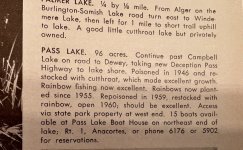
SF -
Pass is an interesting example. Old records show that the 1946 rehab killed 100,000s perch. I don't believe it has been treated since 1959. Currently Pass has fathead minnows, green sunfish, bluegills and perch (at least those that I have seen) and would be potential candidate for a rehab treatment. Those fry planted fish that survive are wonderful trout and with a moderate planting rate (say about 10,000 per year) would likely produce a fishery for most of its anglers; decent catch rates with carryover rainbows reaching 20 or more inches. That said it is in a State Park which would have to be on board with a treatment.
Curt
Pass is an interesting example. Old records show that the 1946 rehab killed 100,000s perch. I don't believe it has been treated since 1959. Currently Pass has fathead minnows, green sunfish, bluegills and perch (at least those that I have seen) and would be potential candidate for a rehab treatment. Those fry planted fish that survive are wonderful trout and with a moderate planting rate (say about 10,000 per year) would likely produce a fishery for most of its anglers; decent catch rates with carryover rainbows reaching 20 or more inches. That said it is in a State Park which would have to be on board with a treatment.
Curt
That’s a solid rant but it doesn’t vibe with my experience. Take Lenice as an example. For many years the state has been stocking there with catchable size rainbows rather than fingerlings. This change came not to spite “serious” anglers but because survival of fingerlings was poor. The result is that all the fish stocked are available to us to catch, but the catchables rarely survive past a second season and top out in the mid-teens. If you have spent any time there in March, I would challenge you to say there aren’t people being served with this approach. I was there on a weekday shortly after the March 1 opener and counted 50+ anglers with most catching fish. If that’s not your cup of tea, move on.IF WDFW had the intent and the knowledge to manage this lake correctly, it would probably still grow pigs. Some of my first float tube outings with my dad happened at Lenice. I would have been about 6 or 7.
WDFW seems to have a similar management plan for most lakes: dump a bunch of fish in so people can easily catch fish. However, it would be great if they managed a handful of lakes for "serious" anglers who wanted higher quality fish. But they don't care about us.
If you read the recent lake reports on this forum you would see quality fish that have been caught by forum members. Maybe your post was a ploy to get us to dish on our quality fish opportunities? I think the state is doing a good job, given the constraints.
I largely agree.That’s a solid rant but it doesn’t vibe with my experience. Take Lenice as an example. For many years the state has been stocking there with catchable size rainbows rather than fingerlings. This change came not to spite “serious” anglers but because survival of fingerlings was poor. The result is that all the fish stocked are available to us to catch, but the catchables rarely survive past a second season and top out in the mid-teens. If you have spent any time there in March, I would challenge you to say there aren’t people being served with this approach. I was there on a weekday shortly after the March 1 opener and counted 50+ anglers with most catching fish. If that’s not your cup of tea, move on.
If you read the recent lake reports on this forum you would see quality fish that have been caught by forum members. Maybe your post was a ploy to get us to dish on our quality fish opportunities? I think the state is doing a good job, given the constraints.
I prefer the fry plants as they are usually much nicer looking fish and very strong, but the facts are fry survival is not what it used to be.
I would guess one reason is less water flowing into the Lenice/Merry/Nunnally chain than 30 years ago. There are many seep lakes that I used to hunt and even fish in the 80s that are completely dry now. Merry is a shadow of what it used to be. While Lenice and Nunnally have somewhat the same shoreline, there is definitely less water moving through and they get warmer earlier every summer/fall than the previous year. Places on Merry where I could float decoys on a 6 ft line are now less than 2 feet. And all the knee deep shoals are now dry.
Lenice can grow large fish, so it’s a shame in my mind to manage it as a put and take lake.Managed correctly for who? Lenice is a put and take lake.
This is exactly what they do.
My suggestion to those who believe WDFW is maximizing the potential of our lakes; go and fish some BC lakes directly over the border and then fish some Washington lakes just south of the border. Just 10 or 20, or 30 miles apart but much different in terms of quality of fish
Your misrepresenting what I said. I didn’t say they’re aren’t quality fish in Washington Lakes. Based on past experience, our lakes are capable of more. Lenice is a good example. Compare Lenice today to 20 years ago and there is a huge difference.That’s a solid rant but it doesn’t vibe with my experience. Take Lenice as an example. For many years the state has been stocking there with catchable size rainbows rather than fingerlings. This change came not to spite “serious” anglers but because survival of fingerlings was poor. The result is that all the fish stocked are available to us to catch, but the catchables rarely survive past a second season and top out in the mid-teens. If you have spent any time there in March, I would challenge you to say there aren’t people being served with this approach. I was there on a weekday shortly after the March 1 opener and counted 50+ anglers with most catching fish. If that’s not your cup of tea, move on.
If you read the recent lake reports on this forum you would see quality fish that have been caught by forum members. Maybe your post was a ploy to get us to dish on our quality fish opportunities? I think the state is doing a good job, given the constraints.
As far as 50+ anglers with most catching fish; that’s great. But why manage Lenice as a put and take lake where any dummy can catch fish that were reared and fed pellets? It’s too good of a lake for that
The fry are eaten because of sunfish, bluegill, and other species. Part of management is ridding the lake of such fish so fry can be stocked; they grow larger and fight much better due to being more “wild”.
Last edited:
I don’t know what the appropriate density would be. I’d have to do some research.N. Metz - what would correct management of the Lenice look like. Planting densities (fish/acre), species and size at time of release, etc.
What does the "serious" angler consider to be higher quality fish? I always look forward to posts by anglers like Billy and Tripoidjunkie which annually seem to catch and number of what I would consider to be quality fish that I believe are coming from Washington lakes.
Curt
As far as species, it was fun catching tigers and browns as well as rainbows. I understand they got rid of the tigers and browns over concern of them getting into the creek and then the Columbia. So if that is the case, I’d be happy with just rainbows.
They probably need to nuke the lake and get rid of the bluegills and sunfish
For anyone who is interested in learning more about the how’s and why’s of managing our trout lakes, I’d suggest contacting your regional WDFW biologist. But probably don’t start by informing them that they don’t care about “serious anglers” 
BC lakes typically don’t have spiny ray species, for starters.
BC lakes typically don’t have spiny ray species, for starters.
Looks like Willy was kicking some ass!Ron I use a Measure Net and journal every fish and refuse to lie to myself...
So, the Average Fish Size at Lencie from March 1 - 17 was.... 15.24 inches.
Largest fish to my net measured multiple times with multiple photos... 18.25 inches
View attachment 58952
Smallest fish to my net measured... 11 inches
View attachment 58953

